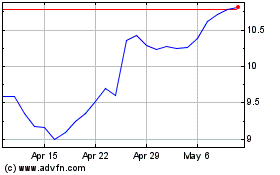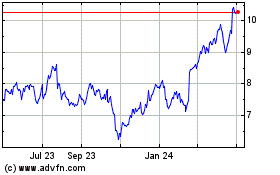Barclays, FactSet Offer New Tool to Navigate Opaque Bond Market
January 15 2020 - 1:58PM
Dow Jones News
By Julia-Ambra Verlaine
Barclays PLC and data provider FactSet are teaming up to bolster
transparency in the opaque bond markets.
The 325-year-old U.K. bank, run by Chief Executive Jes Staley,
said Wednesday it is making a proprietary tool it uses to measure
liquidity in more than 22,000 bonds available to subscribers of
FactSet, leveraging its own internal data on $50 trillion of
fixed-income securities.
Data is the next frontier for large investment banks, which sit
between transactions executed as hedge funds, asset managers,
pensions funds and insurers move money around the globe in
financial markets.
Rival investment banks on Wall Street -- including Goldman Sachs
Group Inc. and JPMorgan Chase & Co. -- have hired troves of
data scientists and technologists to build new platforms and
systems that can harness large amounts of information to glean
insights into trading behavior or how financial instruments
move.
"New data and technology are driving change across the
investment industry at an unprecedented pace, and we are
increasingly seeing this impact in fixed income," said Rich Newman,
global head of content and technology solutions at FactSet.
The Barclays tool, known as the Liquidity Cost Scores (LCS), is
a massive undertaking using computer programs to compile and
analyze two-way prices made by human traders across a broad range
of securities, from U.S. investment-grade bonds to emerging-market
bonds.
Barclays created LCS in 2009, and it is intended to reflect the
cost of an immediate, institutional-size, round-trip transaction.
It is expressed as a percentage of the bond's price.
"Asset managers tend to prefer liquidity analytics that are
intuitive" said Amy Mignosi, a member of the Barclays Live sales
team, in an interview with The Wall Street Journal. "LCS is based
off actual two-way quotes from our trading desks. Its calculation
does not involve complex mathematical models."
Barclays was a first mover in building electronic-trading
systems for currency markets in the early 2000s, alongside Deutsche
Bank AG. Now it sees the benefit in monetizing its data around
liquidity -- an issue that became a greater focus for investors
after a series of hiccups in markets including the spike in repo
rates in September 2019 and volatility in oil in August 2019.
Liquidity is a measure of how easy it is to buy or sell
different investments. When it dries up, it has the power to
dislocate prices, and at its most extreme it can bankrupt financial
institutions or asset managers.
"Market liquidity is an ever-present concern for fixed-income
portfolio managers," said Vadim Konstantinovsky, a senior Barclays
quantitative research analyst, in an interview with the Journal.
"Transaction-costs considerations always factor into their decision
making. Many a strategy promising strong performance turns out
unprofitable when the cost of execution is taken into account."
For FactSet, the deal underscores a trend in fixed-income
markets: the quest for transparency.
While equities and currencies are mostly traded via electronic
platforms, the bond markets have been slower to modernize. The
majority of transactions remain "over-the-counter" -- meaning that
they aren't cleared, trades aren't publicly listed, and they take
place between two parties, usually over the phone or via electronic
chats.
But that is starting to change. Electronic trading in the
corporate-bond market surged to 34% of investment grade
corporate-bonds, according to a recent study by research by
analytics firm Greenwich Associates.
(END) Dow Jones Newswires
January 15, 2020 13:43 ET (18:43 GMT)
Copyright (c) 2020 Dow Jones & Company, Inc.
Barclays (NYSE:BCS)
Historical Stock Chart
From Mar 2024 to Apr 2024

Barclays (NYSE:BCS)
Historical Stock Chart
From Apr 2023 to Apr 2024
